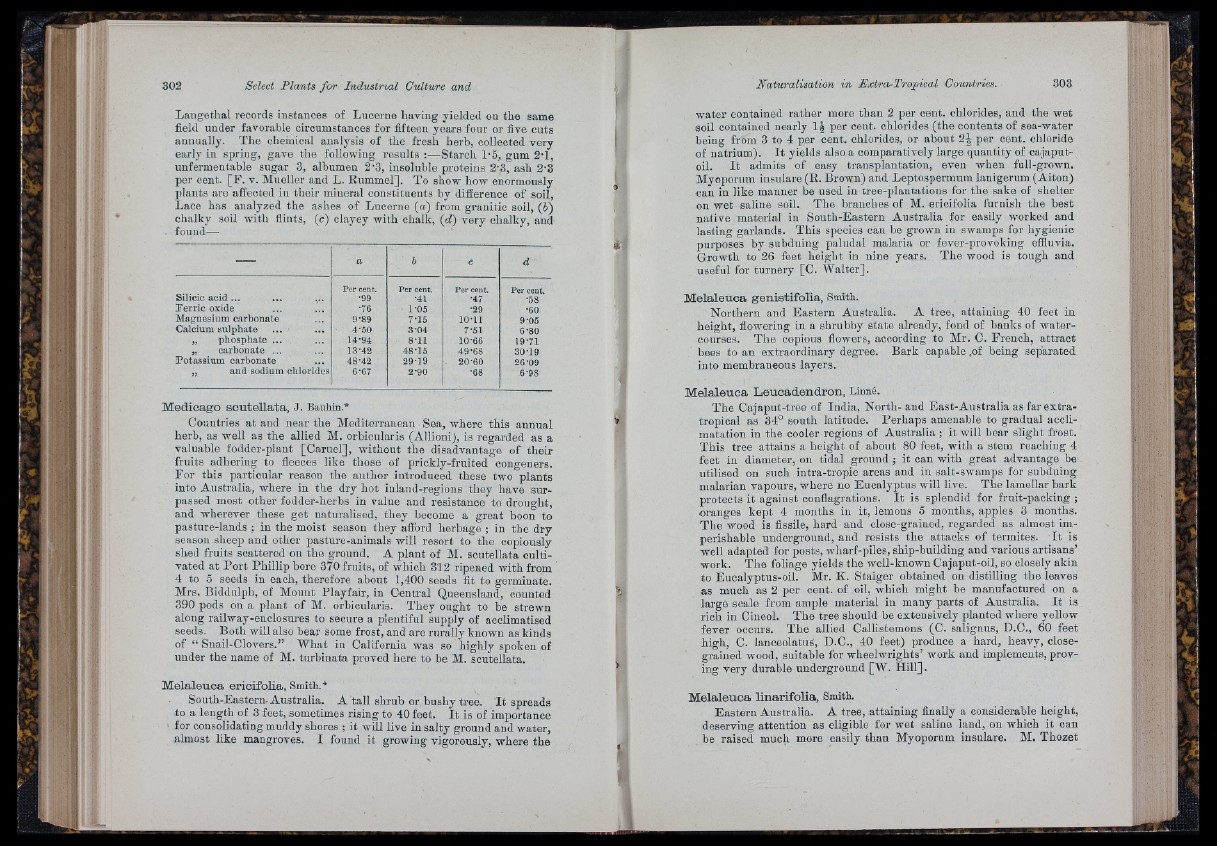
Langethal records instances of Lucerne having yielded on the same
field under favorable circumstances for fifteen years four or five outs
annually. The chemical analysis of the fresh herb, collected very
early in spring, gave the following results :— Starch LS, gum 2-1,
unfermentable sugar 3, albumen 2'3, insoluble proteins 2'3, ash 2'3
per cent. [F . v. Mueller and L. Rummel]. To show how enormously
plants are affected in their mineral constituents by difference of soil.
Lace has analyzed the ashes of Lucerne {a) from granitic soil, (6)
chalky soil with flints, (c) clayey with chalk, (d) very chalky, and
found—
Silicic acid ... ...
Ferric oxide
Magnesium carbonate
Calcium sulphate
„ phosphate ...
„ carbonate ...
Potassium carbonate
,, and sodium chlorides
Per cent.
•99
•76
9-89
4-50
14-94
13*42
48*42
6-67
Per cent.
•41
1-05
7-15
3-04
8*11
48*15
29-19
2*90
Per cent.
•47
•29
10*11
7-51
10*66
49*68
20*60
•68
Per cent.
•58
•60
9*05
6*80
19*71
30*19
26*09
6*98
Medicago scutellata, J. Bauhin.*
Countries a t and near the Mediterranean Sea, where this annual
herb, as well as the allied M. orbicularis (Allioni), is regarded as a
valuable fodder-plant [Caruel], without the disadvantage of their
fruits adhering to fleeces like those of priokly-fruited congeners.
For this particular reason the author introduced these two plants
into Australia, where in the dry hot inland-regions they have surpassed
most other fodder-herbs in value and resistance to drought,
aud wherever these get naturalised, they become a great boon to
pasture-lands : iu the moist season they afford herbage ; in the dry
season sheep and other pasture-animals will resort to the copiously
shed fruits scattered on the ground. A plant of M. scutellata cultivated
at P o rt Phillip bore 370 fruits, of which 312 ripened with from
4 to o seeds in each, therefore about 1,400 seeds fit to germinate.
Mrs. Biddulph, of Mount Playfair, in Central Queensland, counted
390 pods ou a plant of M. orbicularis. They ought to be strewn
along railway-enclosures to secure a plentiful supply of acclimatised
seeds. Both will also bear some frost, and are rurally known as kinds
of “ Snail-Clovers.'” What in California was so highly spoken of
under the name of M. turbinata proved here to be M. scutellata.
Melaleuca ericifoUa, Smith.*
South-Eastern. Australia. A ta ll shrub or bushy tree. I t spreads
to a length of 3 feet, sometimes rising to 40 feet. I t is of importance
for consolidating muddy shores ; it will live in salty ground and water,
almost like mangroves. I found it growing vigorously, where the
water contained rather more than 2 per cent, chlorides, and the wet
soil contained nearly 11 per cent, chlorides (the contents of sea-water
being from 3 to 4 per cent, chlorides, or about 2^ per cent, chloride
of natrium). I t yields also a comparatively large quantity of cajaput-
oil. I t admits of easy transplantation, even when full-grown.
Myoporum insulare (R. Brown) and Leptospermum lanigernm (Aiton)
can in like manner be used in tree-plantations for the sake of shelter
ou wet saline soil. The branches of M. erioifolia furnish the best
native material in South-Eastern Australia for easily worked and
lasting garlands. This species can be grown in swamps for hygienic
purposes by subduing paludal malaria or fever-provoking effluvia.
Growth to 26 feet heiglit in nine years. The wood is tough and
useful for turnery [C. Walter].
Melaleuca genistifolia, Smith.
Northern and Eastern Australia. A tree, attaining 40 feet in
height, flowering in a shrubby state already, fond of banks of watercourses.
The copious flowers, according to Mr. C. French, attract
bees to an extraordinary degree. Bark capable ,of being separated
into membraneous layers.
Melaleuca Leucadendron, Linné.
The Cajaput-tree of India, N o rth -an d East-Australia as far extra-
tropical as 34° south latitude. Perhaps amenable to gradual accli-
matation in the cooler regions of Australia ; it will bear slight frost.
This tree attains a height of about 80 feet, with a stem reaching 4
feet in diameter, ou tidal ground ; it can with great advantage be
utilised on such intra-tropic areas and in salt-swamps for subduing
malarian vapours, where no Eucalyptus will live. The lamellar hark
protects it against conflagrations. I t is splendid for fruit-packing ;
oranges kept 4 months in it, lemons 5 mouths, apples 3 months.
The wood is fissile, hard and close-grained, regarded as almost imperishable
underground, and resists the attacks of termites. I t is
well adapted for posts, wharf-piles, ship-building aud various artisans’
work. The foliage yields the well-known Cajaput-oil, so closely akin
to Eucalyptus-oil. Mr. K. Staiger obtained on distilling the leaves
as much as 2 per cent, of oil, which might be manufactured on a
large scale from ample material in many parts of Australia. I t is
rich in Cineol. The tree should be extensively planted where yellow
fever occurs. The allied Callistemons (C. salignus, D.C., 60 feet
high, C. lanceolatuS, D.C., 40 feet) produce a hard, heavy, close-
grained wood, suitable for wheelwrights’ work and implements, proving
very durable underground [W. H ill].
Melaleuca RnarifoRa, Smith.
Eastern Australia. A tree, attaining finally a considerable height,
deserving attention as eligible for wet saline laud, on which it can
he raised much more easily than Myoporum insulare. M. Thozet